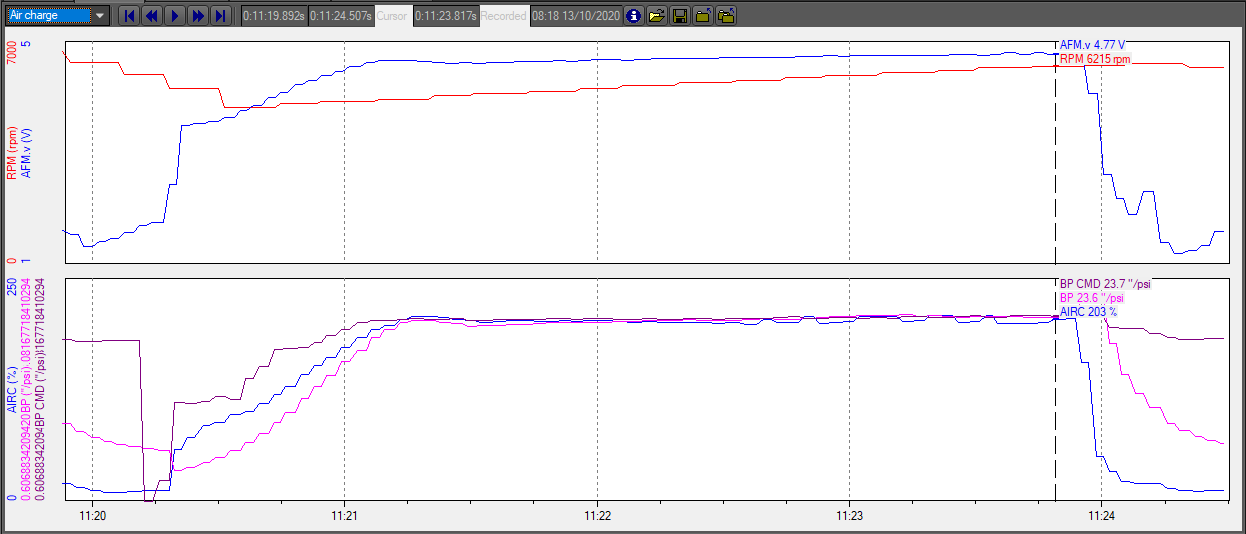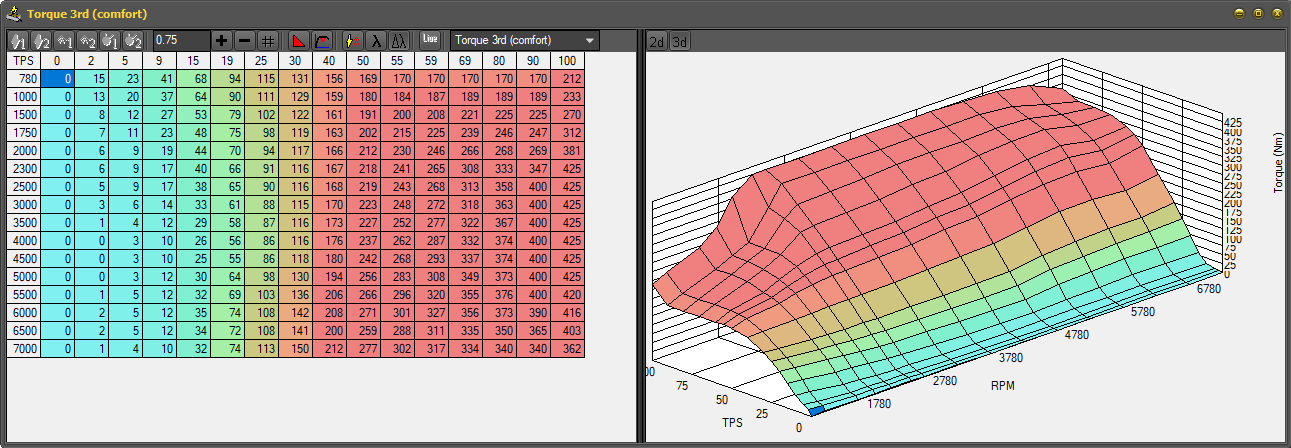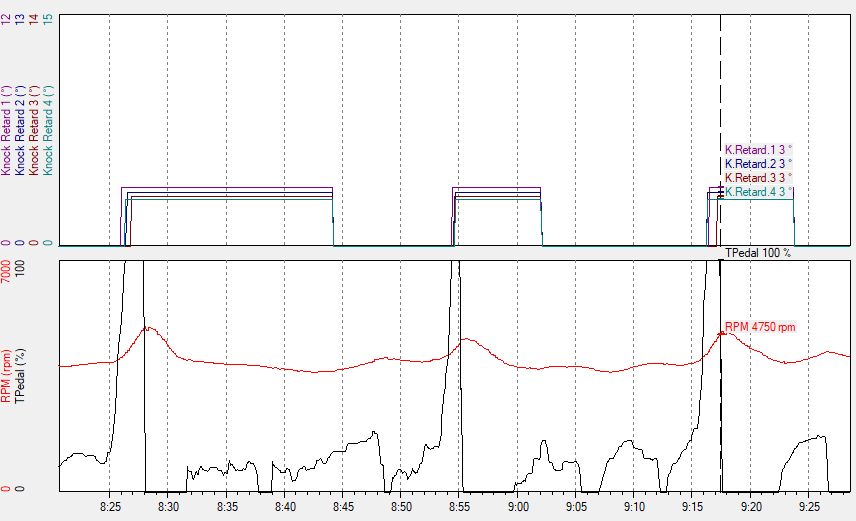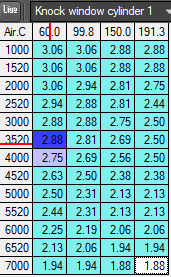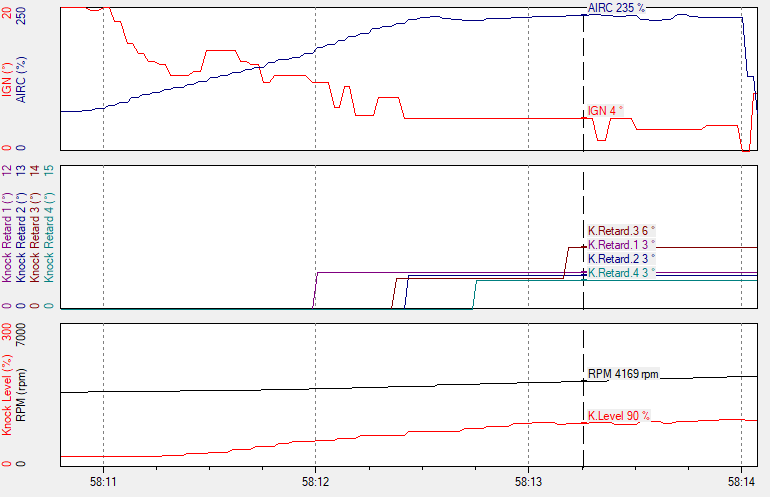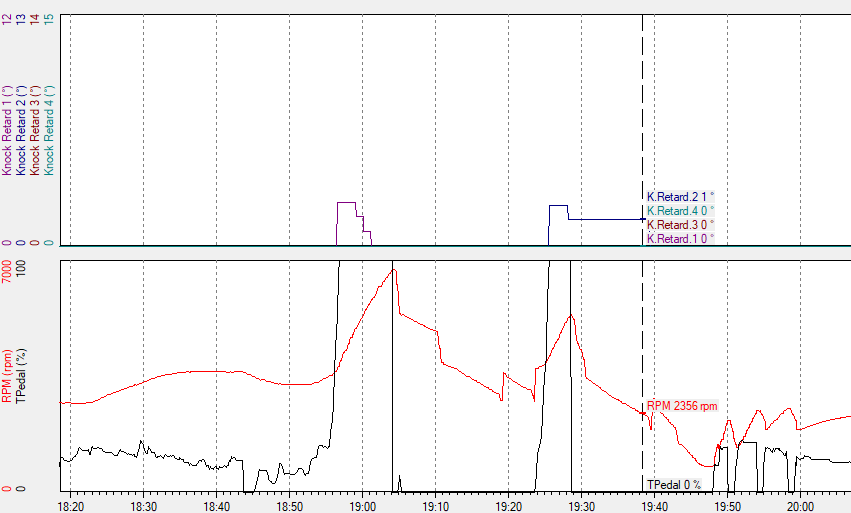Difference between revisions of "Hondata Tuning Guide"
| Line 59: | Line 59: | ||
=== Identifying real knock === | === Identifying real knock === | ||
| − | [[File:Datalog with real knock.png|thumb| | + | [[File:Datalog with real knock.png|thumb|537x537px|A 'rainbow knock' pattern across cylinders, which is almost always real knock.|alt=]] |
Due to the regular presence of noise and false knock, it's important to know what real knock typically looks like on an FK8 and when it can be passed off as noise. Note that 'steps' here refers to the total KR divided by the requested amount of step, not separate increases. For example, 3 steps at -2.25 is -6.75 while with a -0.75 step it's only -2.25, but both indicate the same amount of knock being detected.[[File:False knock.png|thumb|Small single cylinder spikes during throttle changes. This is not a cause for concern, despite consistently occurring.|alt=|left|247x247px]]''Knock can be most easily identified by any number of steps that gradually increase across three to four cylinders, the so called 'rainbow knock'''. Seeing three steps in two cylinders '''or''' more than four steps in a single cylinder is also cause for investigation. | Due to the regular presence of noise and false knock, it's important to know what real knock typically looks like on an FK8 and when it can be passed off as noise. Note that 'steps' here refers to the total KR divided by the requested amount of step, not separate increases. For example, 3 steps at -2.25 is -6.75 while with a -0.75 step it's only -2.25, but both indicate the same amount of knock being detected.[[File:False knock.png|thumb|Small single cylinder spikes during throttle changes. This is not a cause for concern, despite consistently occurring.|alt=|left|247x247px]]''Knock can be most easily identified by any number of steps that gradually increase across three to four cylinders, the so called 'rainbow knock'''. Seeing three steps in two cylinders '''or''' more than four steps in a single cylinder is also cause for investigation. | ||
Revision as of 22:17, 14 October 2020
This guide covers the specifics of tuning a 2017+ Honda Civic Type R from start to finish using a Hondata FlashPro. It was created by Kefi from the FK8 Clinic and is meant for those that are already familiar with EFI tuning and the Hondata interface. There are many videos and courses online about both of those subjects, so many general topics won't be covered in depth here in order to focus on techniques specifically for the FK8. If you do not understand the fundamentals of EFI tuning, you should not attempt to follow this guide blindly. An FK8 ECU is great for someone to learn tuning on, but you must understand electronic fuel injection first.
This guide is meant to be read from start to finish. General information regarding tuning a Type R can be found on the Tuning article.
Disclaimer
You are fully responsible when using the information in this guide. This is meant to be purely informational on a platform where there is very little info, and some things may not be correct or even safe. Many of these techniques are still being refined or even discarded due to the ongoing development of the FK8 platform. While the ECU is considered 'relatively safe' to tune on, you still can push the engine too far and damage it, especially if you are not doublechecking the torque output with a dynamometer.
Core Concepts
To tune a Civic Type R, you must first become intimately familiar with a few concepts that affect nearly every aspect of the tuning process.
Bosch ECU
The 10th generation Civic Type R does not have a Honda ECU, instead featuring a Bosch MED v17.9.3 which is essentially a one-size-fits-all ECU for OEMs. The techniques for tuning them are significantly different.
Luckily, Hondata has managed to make their FlashPro tuning platform and most of the advanced features like traction control work with the Bosch ECU so existing Hondata tuners do not have to learn an entirely new tuning platform. The only other Honda to feature this ECU was the 2015+ European FK2 Civic Type R. It is also commonly seen in BMWs and VWs, although each Bosch ECU has it's own set of techniques the manufacturer has chosen to use.
The biggest thing you'll need to get used to is that the ECU does many things on its own and nearly everything has inertia or PID control. The downside to all this is that the ECU is insanely complex and it's that much harder for Hondata to find the correct tables, parameters, and routines to replace. There are many behaviors we still haven't figured out and may very well never figure out.
This ends up being beneficial to tuners as well, because most of the calculations are all real-time and not hardcoded. We can modify higher level parameters and the ECU will fill in the blanks and keep things in check.
Air charge
The Bosch ECU uses a significantly more accurate load index for targeting fueling, ignition, and cam angles. It calculates how much air is actually inside the cylinder rather than the overall flow through the intake and engine. It is a ratio expressed as a percentage of the physical mass/amount of air in the cylinders at bottom dead center compared to how much the cylinders would hold at the currently measured atmospheric pressure. Anything above 100% and the engine is under boost, anything below 100% is vacuum.
The actual mass of air throughout any turbocharged application's intake and cylinders varies wildly, particularly during sudden throttle changes. Things like VTEC can significantly change the amount of air in the cylinder for each stroke despite the overall flow and calculated engine load not instantly changing, and since VTEC crossover generally happens around peak torque it's vital for this measurement to be correct at that immediate time. By having an immediate measurement of the mass of air in the cylinders instead of just what is passing by the MAF sensor or how much pressure the manifold is under, the Civic Type R is able to target a theoretical amount of torque reliably under all environmental and operating conditions with significantly less room for error, regardless of what modifications are installed.
How air charge is calculated
Air charge is very similar to both SAE absolute and relative engine load and uses the same sensors, but the calculations are time-domain rather than instantaneous and are also significantly more complex. The actual formula is not known or standardized like SAE engine load, but we have a guess. The ECU will first track how much air has flowed past the MAF sensor into the charge pipes, determining how much pressure that airflow is maintaining before the throttle plate using the boost pressure sensor. It will also watch the manifold pressure after the throttle plate to determine how much of the air is entering from the charge pipes, leaving out of intake manifold and thus (hopefully) going into the cylinders. Because the ECU is sampling the MAP sensor in high resolution in order to properly measure the pressure drops as the intake valves open, datalogs will usually show it fluctuating under load by 1 to 2 psi.
This tightly controlled calculation is the reason why the all-too-common vent-to-atmosphere blowoff valves (or any other way for the air to escape unmeasured i.e. boost leaks) or 'performance chips' that intercept the sensors can potentially reduce the reliability and safety of the engine, despite everything looking normal mostly in datalogs.
Torque targeting
Everything begins with the throttle pedal position and current RPM corresponding to a certain amount of requested torque, with an individual table for each gear and drive mode totaling 18 torque request tables.
The ECU will calculate how much air charge and ignition advance is required to achieve the requested torque, up to the limits defined in various tables. The air charge will determine boost pressure command, and then from that the throttle plate position and wastegate position. You do not directly tune boost pressure on an FK8, but you can effectively tune in the same manner as boost by gear with more consistent power results.
While other Honda platforms are compared by their targeted PSI, it is more appropriate to compare an FK8's capability and tune by the targeted air charge.
Flashing
The process to flash a Bosch ECU is exactly the same as a Honda ECU, but it takes significantly longer (five to eight minutes) and requires a short period of driving afterwards to properly learn the stoichiometric lambda baseline before the closed loop system comes online. This means you're looking at roughly eight to twelve minutes between starting the flash and doing another pull.
Monitoring and controlling knock
Unlike other Hondas, the Type R does not use a traditional knock control strategy that learns a fuel's octane level over time. Instead, when the knock sensor picks up noise outside of a certain window, ignition retard is gradually applied to the knocking cylinder and will only remain until throttle input is reset. This system has no memory and will consistently allow knock, albeit rapidly eliminating it once detected.
Due to the nature of this knock strategy, the factory knock sensor calibration is also extremely sensitive and will regularly pick up noise and register more false knock than most platforms. However, because the ignition retard is incremental it has very little effect on power from these tiny false knock events and the sensitivity should generally be left alone unless there is a significant amount of noise from a part such as an exhaust.
This is important to know, because it means that improperly tuning ignition or using low quality fuel can result in consistent knock that never goes away and the driver would never know unless they reviewed their logs.
Calibrating knock retard
There are two parameters to the knock retard system: step and window. The step is how much ignition retard is applied in each 'step' the knock retard system takes expressed as a negative number of degrees, and is -2.25 degrees from factory. It is recommended to set the step to -3 or more when you are working with uncertain fuel or testing new ignition values, and -0.75 to -1.50 if you are certain the fuel is consistently high quality and no knock normally occurs. This is one place where a conservative tune differs from an aggressive one.
The knock windows can also be increased in order to decrease the sensitivity of the knock retard system, but extreme caution should be exercised in doing so because you will potentially miss real knock. Generally speaking, increasing the values by 10 to 20 percent is sufficient for even the noisiest of FK8s. There is a separate table for each cylinder, allowing fine tuning for difficult cylinders. You should adjust it until you're just barely seeing noise, but still seeing it. If you completely eliminate noise, there's a good chance you won't be picking up knock early enough or at all, making the knock retard strategy significantly less effective.
We recommend putting these changes, especially the step, in the tuning notes so that the customer or anyone helping them diagnose issues knows what to expect when looking at datalogs.
Identifying real knock
Due to the regular presence of noise and false knock, it's important to know what real knock typically looks like on an FK8 and when it can be passed off as noise. Note that 'steps' here refers to the total KR divided by the requested amount of step, not separate increases. For example, 3 steps at -2.25 is -6.75 while with a -0.75 step it's only -2.25, but both indicate the same amount of knock being detected.
Knock can be most easily identified by any number of steps that gradually increase across three to four cylinders, the so called 'rainbow knock'. Seeing three steps in two cylinders or more than four steps in a single cylinder is also cause for investigation.
However, seeing lots of little single cylinder one-step spikes across a datalog is not a concern, especially if it occurs right when the throttle is applied and not somewhere along the pull near redline.
